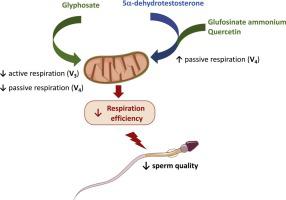Reproductive Toxicology ( IF 3.3 ) Pub Date : 2020-11-26 , DOI: 10.1016/j.reprotox.2020.11.011 Alessandra Ferramosca 1 , Stefano Lorenzetti 2 , Mariangela Di Giacomo 1 , Francesco Murrieri 3 , Lamberto Coppola 3 , Vincenzo Zara 1

|
The widespread cultivation of genetically modified organisms (GMOs) led to a widespread use of selective herbicides to which GMOs are resistant, thus increasing the concern about human exposure to them. Glyphosate (GLY) and glufosinate ammonium (GA), the active principles of the main formulations, have been investigated for their effects on human health, mainly cancer and reproductive toxicity. However, little is known about their effects on the molecular mechanisms related to sperm quality.
To investigate the effects of GLY and GA on mitochondrial respiration efficiency, we took advantage of our already established ex vivo human sperm mitochondria assay. Since spermatozoa are highly regulated by sex steroids, we tested at first testosterone (T), di-hydroxytestosterone (DHT), 17β-estradiol (E2) and progesterone (P4). Then, we tested the effects of GLY and GA and of the hormone-like flavonoid quercetin (QRC) in a dose-dependent manner. The 0.1−1000 nM concentration range has been considered because it covers both the sexual hormones physiologically relevant concentrations (10 nM), triggering endogenously hormone-dependent signaling pathways, and the estimated (nM range) QRC dietary intake. Subsequently, co-incubation experiments were carried out with the two herbicides in the presence of 10 nM of each sex steroid and QRC.
We found that: i) DHT and QRC are able to significantly reduce mitochondrial functionality at concentrations ≥ 10 nM; ii) GLY and GA negatively affect mitochondrial respiration efficiency; iii) in the presence of 10 nM DHT, the negative effect of GLY was increased; iiii) DHT, QRC and GA target mitochondria by using a mechanism different from GLY.
中文翻译:

除草剂草甘膦和草铵膦对人类精子线粒体呼吸效率产生负面影响
转基因生物(GMO)的广泛种植导致了对转基因生物具有抗药性的选择性除草剂的广泛使用,从而增加了人们对人类接触这些除草剂的担忧。主要配方的活性成分草甘膦(GLY)和草铵膦(GA)已被研究其对人类健康的影响,主要是癌症和生殖毒性。然而,人们对它们对精子质量相关分子机制的影响知之甚少。
为了研究 GLY 和 GA 对线粒体呼吸效率的影响,我们利用了已经建立的离体人类精子线粒体测定法。由于精子受到性类固醇的高度调节,我们首先测试了睾酮(T)、二羟基睾酮(DHT)、17β-雌二醇(E2)和黄体酮(P4)。然后,我们以剂量依赖性方式测试了 GLY 和 GA 以及激素类黄酮槲皮素 (QRC) 的作用。 0.1−1000 nM 浓度范围已被考虑,因为它涵盖了性激素生理相关浓度 (10 nM),触发内源性激素依赖性信号通路,以及估计的(nM 范围)QRC 饮食摄入量。随后,在每种性类固醇和 QRC 存在 10 nM 的情况下,用两种除草剂进行共孵育实验。
我们发现: i) DHT 和 QRC 在浓度≥ 10 nM 时能够显着降低线粒体功能; ii) GLY 和 GA 对线粒体呼吸效率产生负面影响; iii) 在 10 nM DHT 存在下,GLY 的负面影响增加; iiii) DHT、QRC 和 GA 通过使用不同于 GLY 的机制来靶向线粒体。











































 京公网安备 11010802027423号
京公网安备 11010802027423号